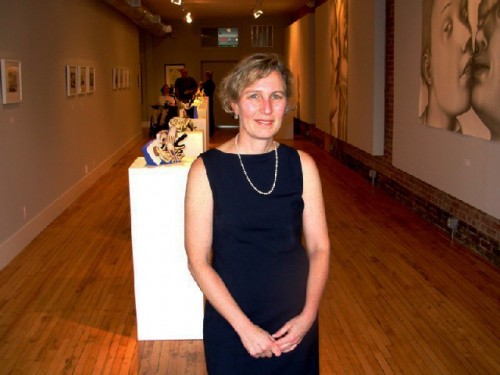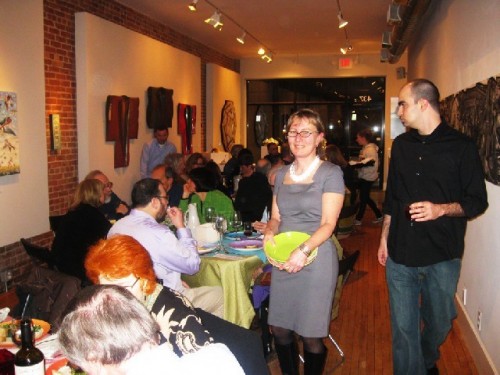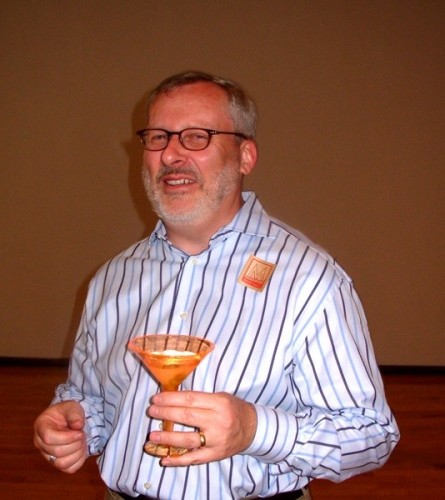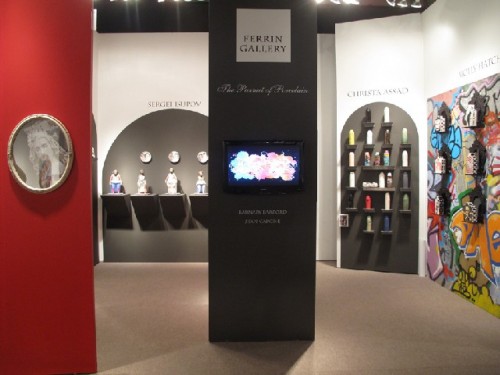Pittsfield Gallerist Leslie Ferrin: Two
Rethinking the Creative Economy
By: Charles Giuliano - Apr 26, 2011
The seasonal nature of the Berkshires is a blessing and a curse for arts organizations.
Much time and effort has been expended on strategies for mutual marketing and promotion. So far, through a general lack of funding and staff time, with not much result. The lack of progress is exacerbated by the poor state of the economy. This in turn has eroded tax revenue resulting in draconian cuts for state and federal arts grants and marketing budgets.
The cycle is that it takes money to make money.
When arts organizations make cuts often it is pr and marketing that suffers the biggest hit. The simple and obvious truth is that if you don’t promote and advertise ticket sales and attendance erode.
A for profit, arts related business, such as Ferrin Gallery, is particularly vulnerable to the ebb and flow of a creative economy. There are no grants or foundations to look to for operating revenue. This may be available to artists represented by the gallery but not to an individual dealer. It takes deep pockets to survive the hard times of the past few years.
When Leslie Ferrin planted roots on North Street she became a high profile leader of the creative economy of Pittsfield. Is her decision to put the space on the market a red flag?
Putting the decision of Ferrin and her business partner, Donald Clark, in perspective one might evoke a sports analogy.
‘The team is never as good as it seems when it is winning. And never as bad as it seems when it is losing.’
Charles Giuliano Now that you are changing your business model, including putting the gallery space on the market, is it safe to assume a change in representation? You are known for a focus on ceramic art. In the move from Lenox to the larger space in Pittsfield you expanded to include more painting, sculpture, and photography. Will you now focus on your area of strength in ceramics?
Leslie Ferrin What has happened in the past four years is that the borders have continued to erode. The same transitions are taking place in the market. Where it makes sense for us to work with an artist it doesn’t make sense for us to narrow it to a medium or a specific market. We are doing art fairs and not just decorative arts or craft fairs. We are doing art fairs like Art Miami, San Francisco, Art LA. These are the kind of places we are going to and our artists are going into photography, digital media, work on paper. Some of the things we were doing in Lenox we are still doing.
When we moved into Pittsfield we started doing local artists who fit in with our sculptors and ceramicists. We probably won’t be doing that. The area has come up with other ways to bring that work out. Storefront has been active in providing a space. They will again when they make their transition and go forward. The Lichtenstein (Pittsfield) and other spaces have taken up what we were doing. So that’s the part, if you were going to say there’s going to be a change. The shows that we are presenting in the Berkshires are the ones that we are presenting at the Fairs. And in our partnerships with other galleries in other cities. We’re limiting the amount of material we have to handle.
Like the show Pursuit of Porcelain which opened in NY last week. A component will go to San Francisco and then it will come back here and be on view from Memorial Day to the middle of July. It opened at SOFA in NY. This particular show is in three components, New York, San Francisco and Pittsfield.
CG Will we see you this summer?
LF We are fully programmed through the summer. Then we’ll reassess where we are at the end of the summer.
We put the space on the market to test the waters. If somebody buys it great. We’re flexible. I’m sure we’ll have four or five months notice. All of our artists know about our plans. Our clients know what we’re doing. I’m pretty optimistic about the summer. There have been transitions so we are between first wave and second wave. In the next couple of years we will see what Kate Maguire (director of the Colonial Theatre and Berkshire Theatre Festival) did that is different than (former director) David Fleming. With a new person at the Berkshire Museum what are they going to do with this opportunity?
CG Barrington Stage and Beacon Cinema appear to be well established. There are more new restaurants. So you get a mixed message. Overall, Pittsfield looks more stable but why did Stuart Chase leave (former director of the Berkshire Museum)?
LF Yes, but if you look at Williams, Lisa Corrin is leaving and now John Stomberg. Somebody said to me about Stuart, well there are 35 great museum directorships open every year. We happened to have a bunch of announcements all at once in Pittsfield. Are you surprised that these things are taking place? Given the economy and the pressures that are on these institutions? It takes money to keep their doors open.
CG Regarding Corrin and Stomberg leaving Williams, I have talked with them, those transitions seem quite natural. They are making life and career decisions in a very logical way. That does not describe Stuart Chase and the Berkshire Museum. He had completed a $9 million renovation and sold the Russian paintings (for $7 million) to increase the acquisition fund. With so many accomplishments why the sudden and mysterious change? It just never made sense.
LF We can both ask the board and what are you going to do about it? Whatever it is that you made that decision about, what are you going to do about it? Whatever reasons they had, and whatever changes they wanted to make, tell us what they are. Lead.
CG If I were a candidate I would wonder about the commitment of the board.
LF I was at the NY Armory with my colleagues some of whom were looking for a job. They looked at the posting and said “What the hell happened?” I said, go up there, and if you get to an interview, call me, and I’ll tell you more about it.
My situation is more about what you are saying about John (Stomberg) and Lisa (Corrin). You take a look at what you are doing, and what you want to do for your future, and your artists’s future. You say, all right, let’s see what we can do.
CG We were just in Boston and Newbury Street is decimated. There are a few galleries hanging on but it is not what it used to be. Your situation is different. Just how many individuals in the country represent your niche (ceramic art)? That describes an entirely different business model than the average gallery.
LF The galleries on Newbury Street were paying a very high rent per square foot. My colleagues in NY are dealing with very high overhead. One of the things that allowed us to develop as specialists, on a global level, is that we were operating with a low overhead in a rural setting. We were able to do things that they weren’t able to do because they were relying on walk in traffic in a high rent setting. Over a period of years we were able to look at all the different business models. The art business is like roulette. You put the work out there and hope that somebody comes along to buy it. When you can’t pay your rent on Newbury Street, or wherever people had galleries, it’s a changing business.
My question would be who are the younger people and what are they doing to represent artists? Are they coming up with different business models? There is one artist we are dealing with, Molly Hatch. She is doing art and anthropology as a designer. They’re not looking at an art career in the same way. The younger artists are much broader. Their business models are broader. So I think we are ahead of the curve.
CG You seemed to have a very well thought out plan. What blew you off track?
LF I think it is the doors that have opened not the doors that have closed. I think it is pretty exciting to think that an artist, Chris Antemann, that started with me ten years ago in Lenox, is the first artist to go to the Meissen company in 300 years. To use the Meissen company as their studio to make contemporary work. That’s a door that’s opened and I want to walk through it with her. I want to go to Dresden. I want to look at what they are doing.
There are all these large elite companies. Swarovski is one of them and they have attached themselves to contemporary art as a way of reconfiguring themselves as a company. Their three top markets are Dubai, Tokyo and Singapore. If our partnership with Chris and them succeeds we would start to work with their product in editions. Alongside of her unique pieces that are made in her studio. As well as the photography which is produced as a second medium for her.
These are great opportunities and I can’t do that and service a large body of regional artists. What you are asking is, if the recession weren’t so severe, could I do both? The answer is yes.
CG Of the artists you represent is it fair to say that a small number of artists are bringing in the greatest share of income?
LF We just showed 14 artists in NY of which eight of them did significant projects. The others were there with related works. At this show three generations were represented. I had Molly Hatch who’s 30, Chris Antemann who’s 40, and Sergei Isupov who’s almost 50. They are riding off each other’s coat tails. Sergei is gaining off of what Chris is doing as is Molly. I get very excited about the younger artists whose careers are taking off.
CG What are Sergei’s top prices at this point?
LF About $50.000. We have a major mural that’s more but we haven’t sold it.
CG Molly Hatch?
LF Individual pieces are a thousand.
CG That’s a big gap from a thousand to fifty.
LF She’s 30 and we have worked together for just a year. Chris is 40 and I’ve worked with her for ten years and Sergei for 15. Not everyone is a success story like these three.
CG What happens to painters you represent like Maggie Mailer?
LF She had her most successful show last year. I’m not worried about her and we will continue to represent her. She is in our rotation and if we were there next year I would schedule another solo show with her. We can’t have the same artists every year. It’s not good for them. We have a solo scheduled with Gordon Chandler on July 30. This will be our third or fourth show with him and it was our third or fourth show with Maggie. There are certain people who are suited to showing in the Berkshires. As long as we have that space we will do that. Maggie and Gordon have galleries showing them other than us. We are their regional representation. I have been encouraging Maggie to identify one (gallery) or to let me help her.
CG The Berkshires need a lot more local galleries.
LF We served that purpose for awhile. There are others who can run with it. There’s The Gallery Association, Berkshire Creative, Down Street, Cultural Pittsfield, they are all much more evolved than four years ago when we opened. I would hope that these organizations would continue to grow. Third Thursday didn’t exist when we moved to North Street. DownStreet (North Adams summer program) didn’t exist. They are little seeds which will continue to grow. If the economy were good we all would have grown much more.






